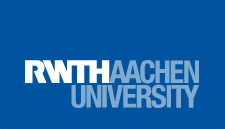Schlagwort: ‘Forschung’
I´m gonna be an Engineer – Team HVT
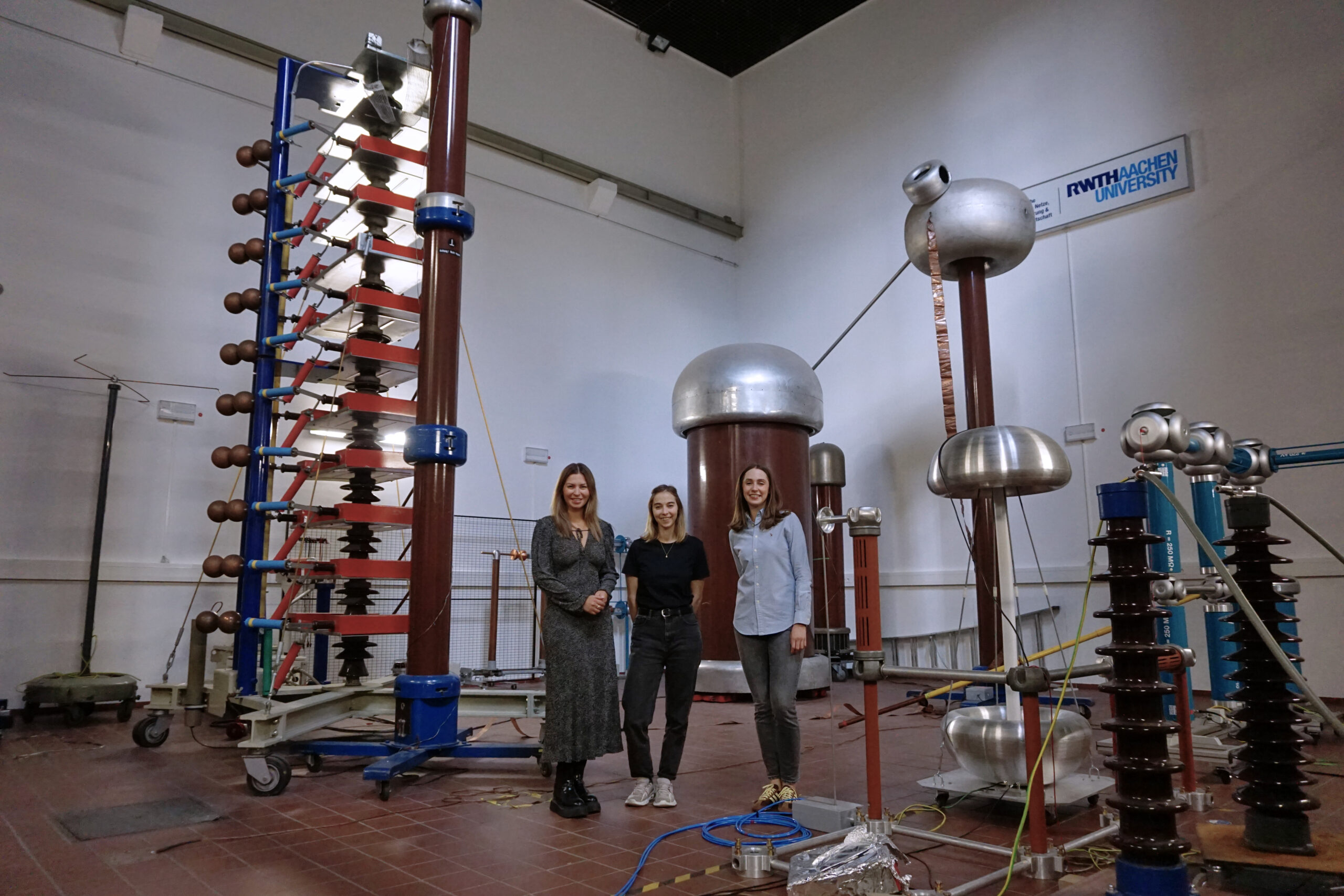
In der Praxis können Blitzeinschläge und andere extreme Einflüsse die Strominfrastruktur an ihre Grenzen führen. Um einen sicheren Betrieb zu gewährleisten, werden Untersuchungen unter Einsatz von Hochspannungserzeugern durchgeführt.
Das Lehr- und Forschungsgebiet für Hochspannungstechnologie (HVT) beteiligt sich aktiv an der Entwicklung neuer Lösungen für die Energiewende. Drei Teammitglieder geben hier einen Einblick in ihren Berufsalltag.
Mit eurer Forschungsarbeit setzt ihr euch dafür ein, die Grenzen der Innovation im Energiesektor zu verschieben. Aber wo habt ihr angefangen? Alexandra, welche Schulfächer haben dich interessiert und wie ging es weiter?
„Die Reise in den Energiesektor begann für mich bereits in der Schulzeit. Schon früh hatte ich ein starkes Interesse an den naturwissenschaftlichen Fächern, besonders an Physik und Mathematik. In meiner Schulzeit hatte mein Gymnasium eine direkte Kooperation mit der Universität, an der ich später meinen Bachelorabschluss gemacht habe. Im Rahmen dieses Programms konnten wir nach dem Unterricht an zusätzlichen Kursen teilnehmen, durch die wir verschiedene Aspekte und Arten von MINT-Fächern besser kennenlernen konnten. Physik hat mich immer fasziniert, aber es wurde schnell klar, dass ich lieber ein Ingenieurfach studieren wollte. Was mich letztendlich zur Elektrotechnik führte, war mein Wunsch, konkrete Probleme zu lösen und Innovationen voranzutreiben.“
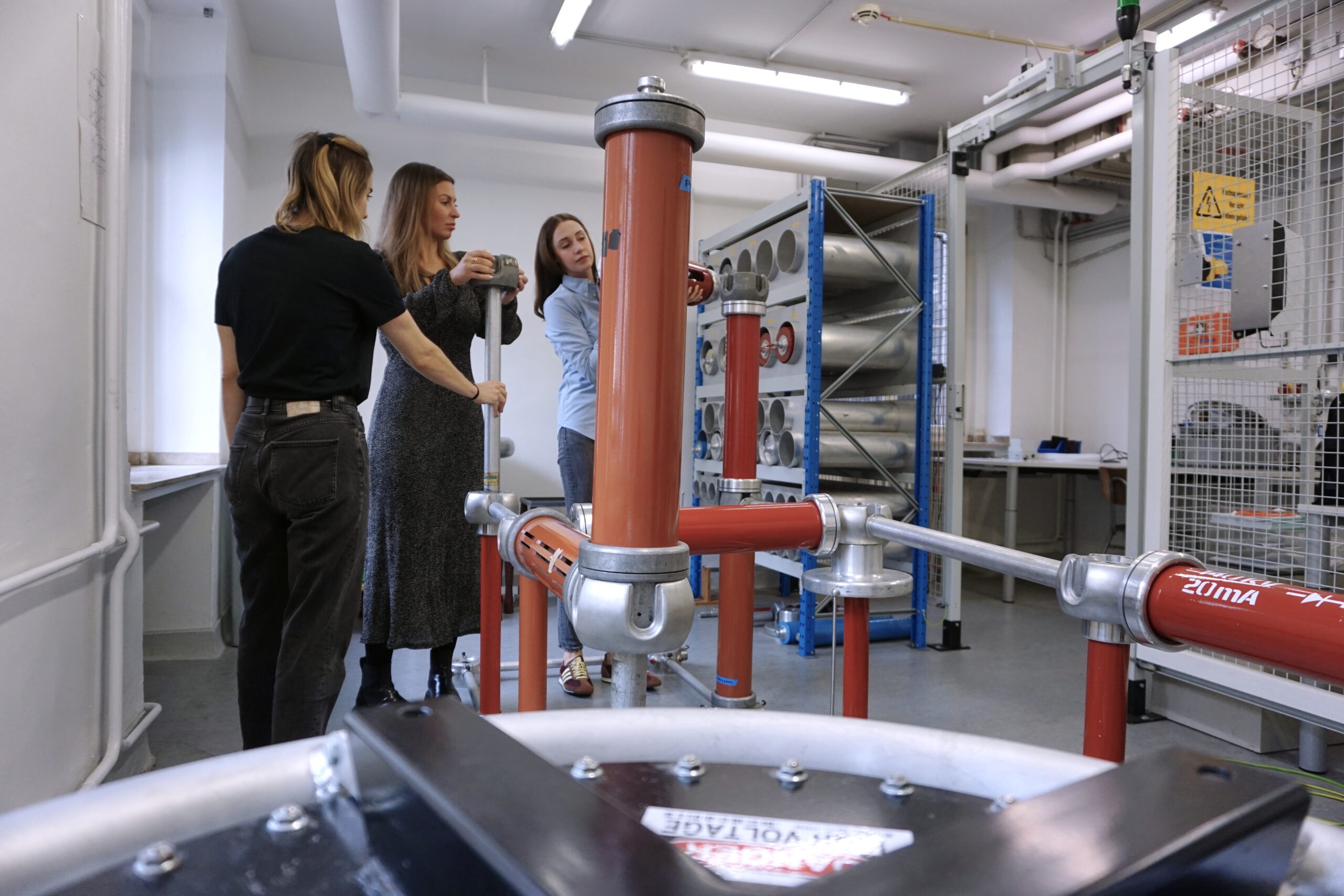
Für Studierende der Fachrichtung Elektrotechnik und Informationstechnik steht ein Prüfstand bereit, an dem sie die Möglichkeit haben, ihr theoretisches Wissen in der Praxis zu erproben.
Der rasche Umbau des Energiesystems bringt neue Herausforderungen mit sich. Stromautobahnen (Übertragungsnetze) wie Südlink und Südostlink sollen Strom aus On- und Offshore-Windparks aus dem Norden in alle Teile der Bundesrepublik transportieren. Dabei kommt die Hochspannungs-Gleichstrom-Übertragung (HGÜ) zum Einsatz. Ihr forscht an Isoliersystemen unter Gleichstrombelastung. Was sind die Vorteile von Gleichstrom (DC) gegenüber Wechselstrom (AC)? Und warum ist ein zuverlässig funktionierendes Isolationssystem besonders wichtig?
„Projekte wie Südlink und Südostlink nutzen Hochspannungs-Gleichstrom-Übertragung, um Strom effizient über weite Strecken zu transportieren. HGÜ hat gegenüber Wechselstrom den Vorteil, dass es geringere Übertragungsverluste, höhere Übertragungskapazitäten und eine verbesserte Netzstabilität bietet. Außerdem kann HGÜ einfach in bestehende Netze integriert werden. Ein zuverlässig funktionierendes Isolationssystem ist dabei besonders wichtig, weil es die Sicherheit und Effizienz der gesamten Übertragung gewährleistet. Neben dem Standhalten der hohen Belastungen durch die Energieübertragung im stationären Zustand muss die Isolierung auch kurzfristige Transienten mit Überspannungen aushalten können. Die korrekte Funktion des Isolationssystems ist entscheidend für den ordnungsgemäßen Betrieb des gesamten Energiesystems, da kritische Infrastrukturen wie Energiekabel sowie Umrichter- und Leistungstransformatoren ein einwandfrei funktionierendes Isolationssystem benötigen. Unsere Forschung konzentriert sich darauf, diese Systeme zu optimieren und somit die Zuverlässigkeit und Lebensdauer der Übertragungsnetze zu erhöhen, was letztlich die Energiewende unterstützt.“
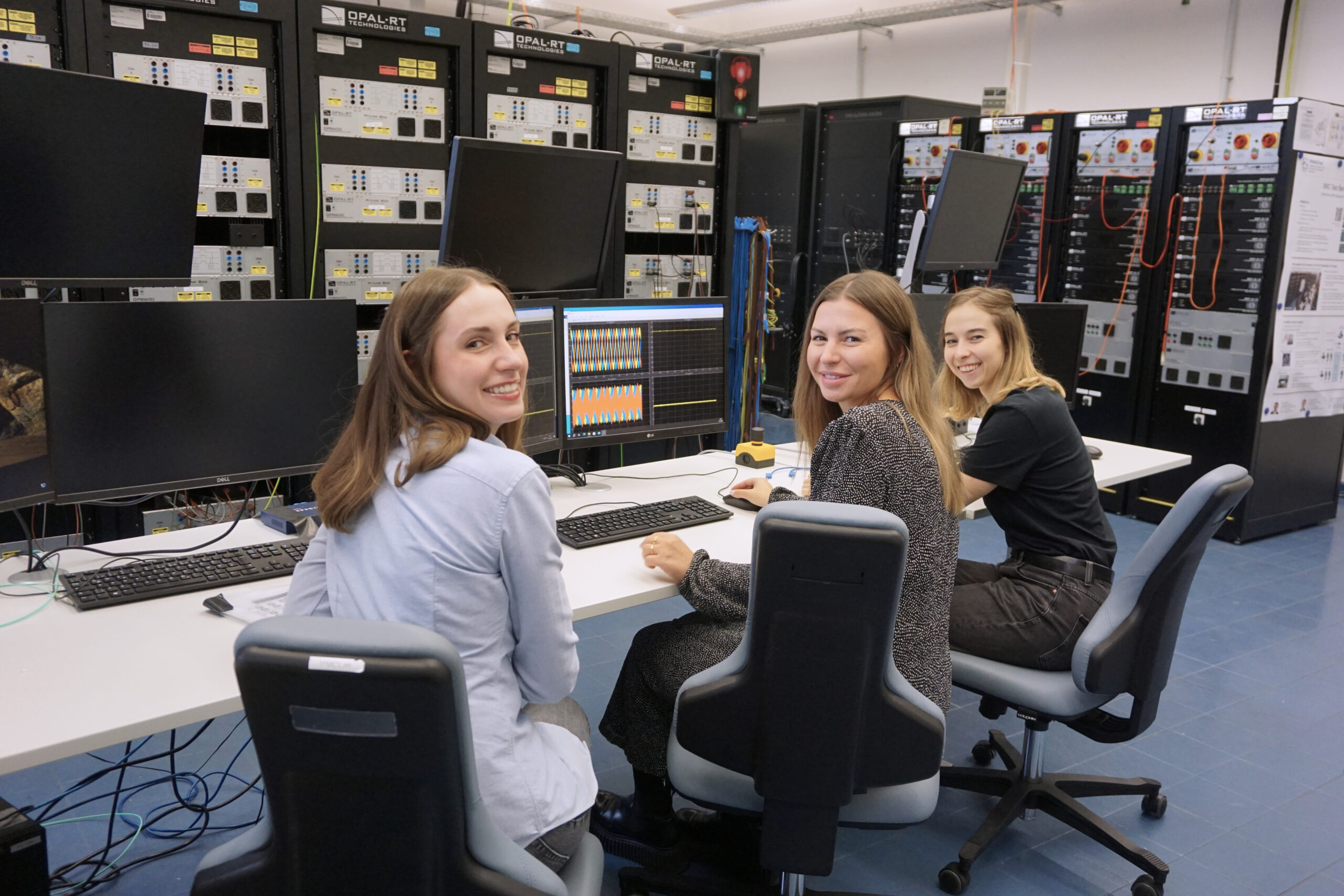
Ein Anwendungsbeispiel für das MMC Test Bench: Die sichere und „intelligent“ geregelte Integration von Strom aus Offshore-Windparks in das Übertragungssystem an Land. Acht laborskalierte modulare Multilevel-Umrichter (MMCs) ermöglichen die Simulation verschiedener Systeme und Szenarien in Echtzeit und machen die Umsetzung der Energiewende planbar.
In einer Vision der Zukunft fahren wir in autonomen Automobilen, die wir mit regenerativem Strom aus dem „intelligenten Stromnetz“ aufladen. Welche Anforderungen werden aus Sicht eurer Forschung an das Stromnetz gestellt? An welchen zukunftsweisenden Entwicklungen arbeitet ihr? Und welche Projekte findet ihr besonders spannend?
„Das Stromnetz muss zahlreiche Anforderungen erfüllen, um die Energieversorgung zuverlässig und effizient zu gestalten. In unserem Forschungsbereich arbeiten wir an verschiedenen Aspekten der Energiewende, unterteilt in die Teams Isoliersysteme, Primärtechnik und Diagnostik sowie DC-Systeme. Dies ermöglicht uns, sowohl das „große Bild“ des Stromnetzes als auch das „kleine Bild“ der entscheidenden Komponenten im Stromnetz abzudecken. Da der Fokus heutzutage auf dem neuen grünen Energiesystem liegt, das aus erneuerbaren Energien und umweltfreundlichen Leistungsschaltern besteht, arbeiten wir an spannenden Projekten, die diese Transformation ermöglichen. Dazu gehören unter anderem DC-Schalter für Gleichstromsysteme und moderne, umweltfreundliche Isoliersysteme für verschiedene Anwendungen. Ein weiterer wichtiger Aspekt unserer Arbeit ist die Integration neuer Technologien in bestehende Systeme, um einen reibungslosen Übergang zu gewährleisten. Besonders spannend finde ich Projekte, die sich mit der Weiterentwicklung und Anpassung der vorhandenen Ausrüstung im Rahmen der Energiewende beschäftigen. Diese Arbeit trägt dazu bei, dass das bestehende Stromsystem weiterhin effizient und zuverlässig funktioniert, während wir gleichzeitig die Umstellung auf erneuerbare Energien und moderne Technologien vorantreiben.“
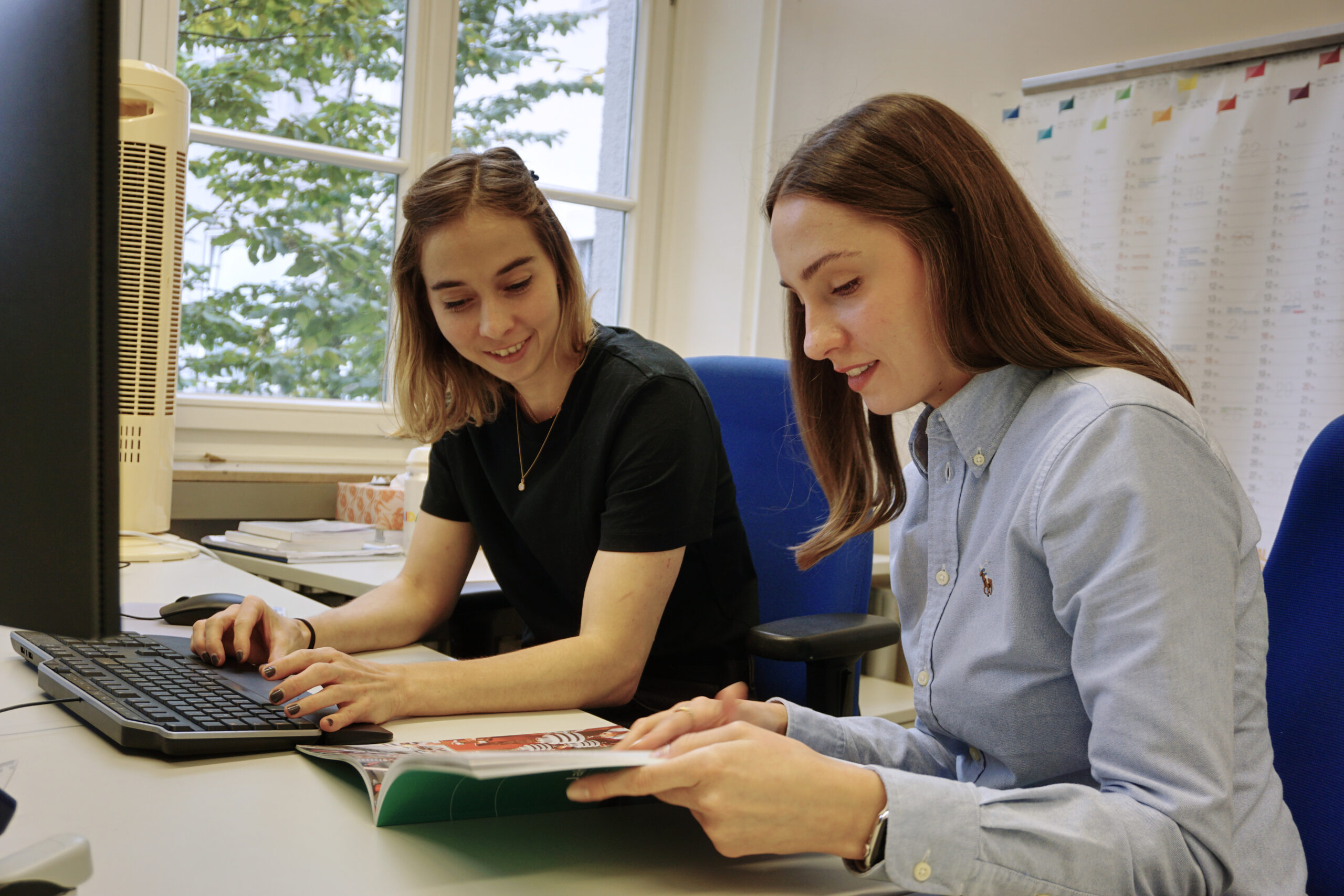
Von links: Verena West forscht an neuartigen Leistungsschaltern als Komponenten eines vermaschten Wechselstromnetzes. Aleksandra Wiecha beschäftigt sich in ihrer Forschungsarbeit mit der Lebensdauer von Isoliersystemen unter den Anforderungen dezentraler Energieerzeugung und -versorgung.
Eure Forschung umfasst ein breites Spektrum von modernen elektrischen Anlagen bis hin zu Regelungs- und Schutzkonzepten für zukünftige Stromnetze. Dafür steht euch eine hochmoderne Laborinfrastruktur zur Verfügung. Verena, wie sieht ein typischer Arbeitstag aus? Welche Arbeitsinhalte sind darüber hinaus wichtig? Welchen Stellenwert haben Teamarbeit und andere Soft Skills?
„Morgens beginne ich mindestens eine Stunde bevor ich mit den Studierenden (AbschlussarbeiterInnen und HiWis) im Labor anfange. In dieser Zeit bearbeite ich meine E-Mails und versuche mir Zeit für die Arbeit an meinem Dissertationsthema zu nehmen. Wenn die Studis da sind, gehen wir den Plan für den Labortag durch und ich gebe ihnen die Freigabe, mit den Experimenten zu beginnen. Danach setze ich mich wieder an den Schreibtisch und arbeite an verschiedenen Projekten, der Auswertung von Versuchsergebnissen oder an meiner Dissertation. Falls es Probleme im Labor gibt, helfe ich dort aus. Für mich steht die Teamarbeit hier besonders im Fokus, da man ohne Zusammenarbeit im Labor nicht weit kommt. Dabei ist gerade die Unterstützung und Einarbeitung von erfahrenen KollegInnen sehr hilfreich. Da die Arbeit als wissenschaftliche Mitarbeiterin viele verschiedene Themen umfasst, ist auch die Fähigkeit sich schnell in neue Problemstellungen hereinzuarbeiten, enorm wichtig, ebenso wie ein gutes Zeitmanagement.“
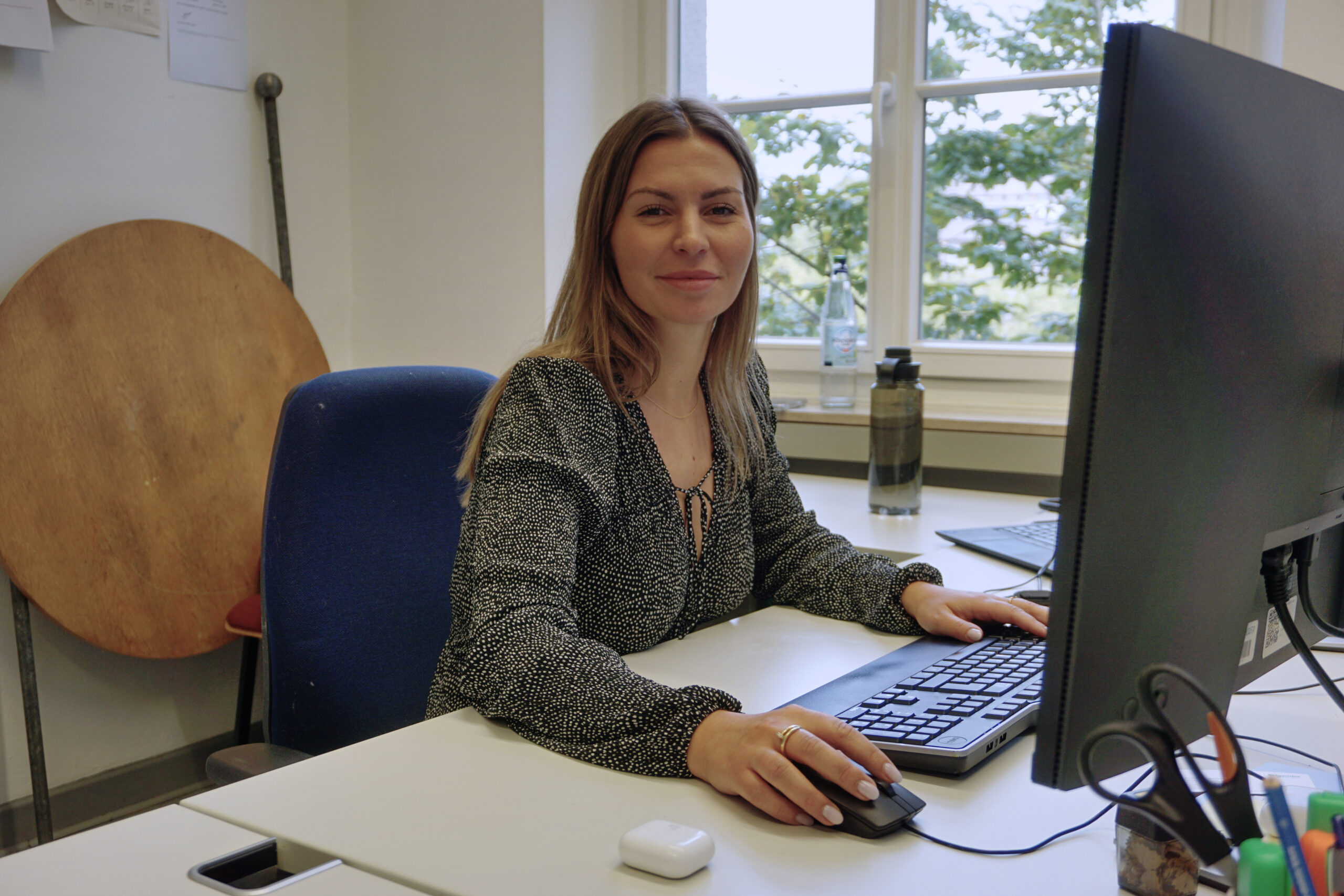
In ihrer Forschungsarbeit untersucht Sarah Anhaus den Schutz von Wechselstromleitungen im Übertragungsnetz bei steigendem Anteil erneuerbarer Energien.
Vielfalt und Chancengleichheit sind zentrale Werte in eurem Team. Sarah, was bedeutet Work-Life-Balance für dich persönlich und lebst du sie bereits?
„Work-Life-Balance ist in der heutigen Zeit ein beliebtes Trendthema. Neben meinem Arbeitsleben pendle ich regelmäßig zwischen meinem Wohnort Bayern und Aachen. Diese Situation stellt eine besondere Herausforderung dar, eine perfekte Balance zu finden. Ich habe gelernt, dass Work-Life-Balance nicht unbedingt eine gleichmäßige Verteilung der Zeit zwischen Arbeit und Privatleben bedeutet. Vielmehr geht es darum, Prioritäten zu setzen und Kompromisse einzugehen, um beide Bereiche bestmöglich zu integrieren. Es ist entscheidend, individuell zu definieren, was Work-Life-Balance für einen selbst bedeutet, anstatt sich nur an allgemeinen Trends zu orientieren. Um meine beruflichen und persönlichen Verantwortlichkeiten in Einklang zu bringen, setze ich auf klare Priorisierung und gute Organisation. Ich nehme mir bewusst Zeit für Sport, Unternehmungen mit Familie & Freunden, Reisen und auch für Ruhephasen, um eine nachhaltige Balance zu gewährleisten. Dabei spielt die Unterstützung meines Umfelds eine große Rolle. Natürlich gibt es Phasen, in denen ein Bereich mehr Aufmerksamkeit erfordert als der andere, aber insgesamt strebe ich stets danach, ausgeglichen zu sein.“
Lass dich inspirieren und finde deinen eigenen Weg!
Auf unserer Website informieren wir dich über unser Studienangebot.
A work of possibilities – Team AEV
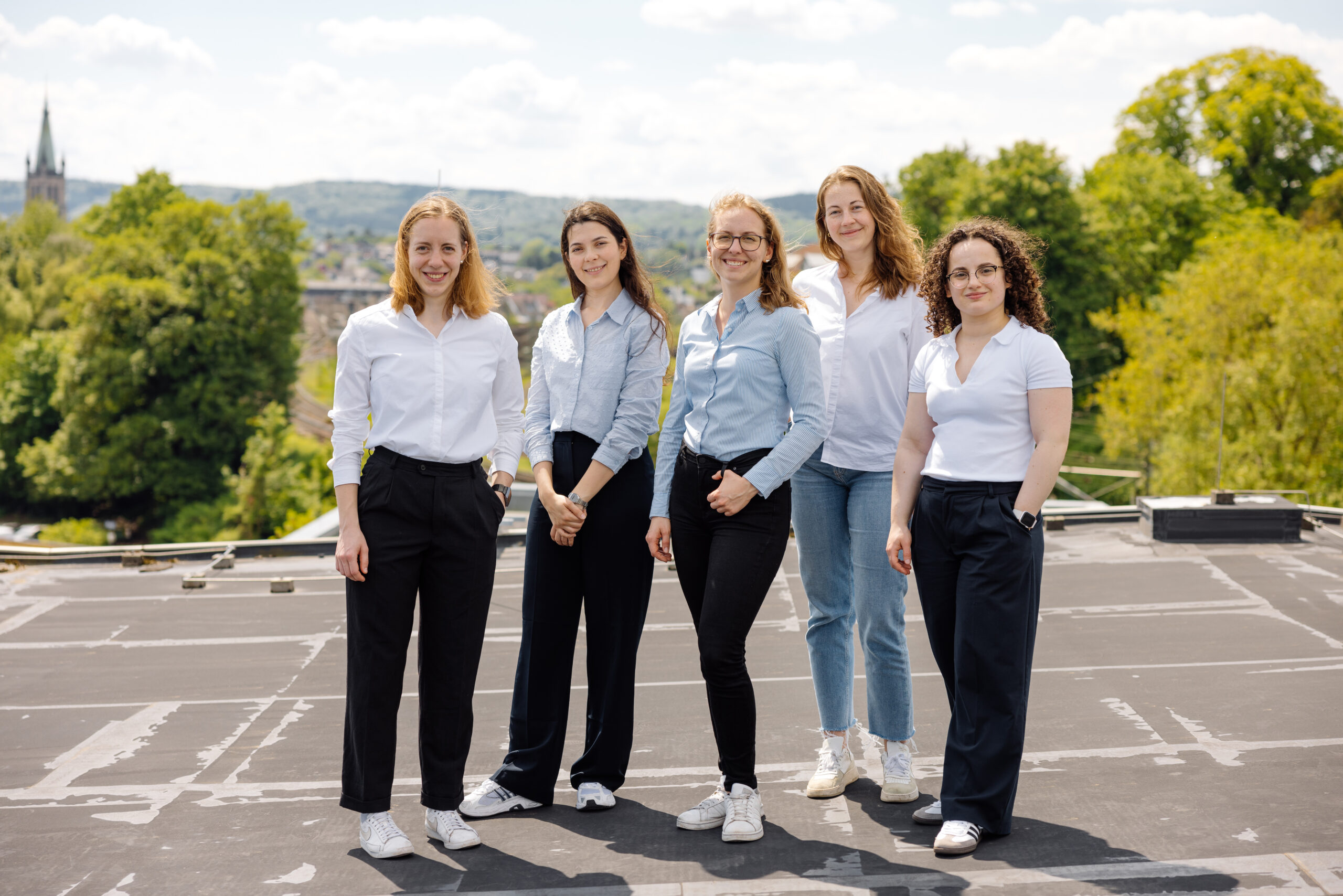
Von links: Almut Herzog, Sarra Bouchkati, Irina Zettl, Franziska Tischbein, Antigona Selimaj © Martin Braun
Am Lehrstuhl für Aktive Energieverteilnetze des Instituts für Elektrische Anlagen und Netze, Digitalisierung und Energiewirtschaft (IAEW) sind aktuell fünf wissenschaftliche Mitarbeiterinnen tätig, die zeigen, wie vielfältig und spannend ein technisches Studium mit anschließender Promotion sein kann.
Jede von ihnen hat einen einzigartigen Bildungsweg hinter sich – von der Elektrotechnik über Wirtschaftsingenieurwesen und Physik bis hin zur Informatik. Was sie alle verbindet, ist eine gemeinsame Motivation: Sie haben Spaß an wissenschaftlichen Themen und wollen mit technischen Innovationen die Zukunft gestalten. Ihre Themengebiete reichen von der Auslegung von Schutzsystemen über Cyber Security bis hin zum Einsatz von KI-Verfahren im Netzbetrieb. Sie arbeiten zum Beispiel simulativ am Computer oder experimentell im Labor, wobei jede ihre eigene Expertise mit einbringen und neues Fachwissen in bisher unbekannten Themengebieten aufbauen kann.
Zu ihrer Motivation, Wirtschaftsingenieurwesen mit Schwerpunkt Elektrotechnik zu studieren, sagt Antigona, Teamleiterin der Gruppe Resiliente Netzleittechnik:
„Schon in der Schule haben mir Mathe und Physik besonders gelegen und großes Interesse geweckt. Die Elektrotechnik als Teilgebiet der Physik faszinierte mich zusätzlich, und von der Kombination mit der Betriebswirtschaft versprach ich mir hervorragende Karrierechancen.“
MINT-Berufe sind nicht nur in vielen Branchen sehr gefragt, sie bieten auch exzellente Berufsaussichten. Die hohe Nachfrage nach qualifizierten Fachkräften sorgt für Arbeitsplatzsicherheit und stabile berufliche Perspektiven. Außerdem eröffnen diese Berufe internationale Möglichkeiten, sei es durch Auslandsprojekte oder die Zusammenarbeit in internationalen Teams.

Einen gesellschaftlichen Beitrag zur Energiewende zu leisten, ist Antigona ein besonderes Anliegen. Dabei sieht sie sich in der Verantwortung, ein Vorbild für junge Frauen zu sein, die ebenfalls eine Karriere im MINT-Bereich anstreben:
„Ich möchte mit gutem Beispiel vorangehen und junge Frauen dazu motivieren, ihre eigenen Potentiale zu entfalten.“
Beim Thema Promotion sind sich alle einig: Sie ermöglicht es, ständig Neues zu lernen und sich selber weiterzuentwickeln. Über die persönliche Verwirklichung hinaus, eröffne ihnen diese Position erst den Weg zu einer aktiven Mitgestaltung der gesellschaftlichen Entwicklung. In der Forschung tätig zu sein bedeute auch, an ebenjenen zukunftsweisenden Projekten mitzuarbeiten, die echte Veränderungen bewirken können.
„Die Promotion erlaubt es uns, an der Spitze technologischer und wissenschaftlicher Innovationen zu arbeiten“, so Antigona.
Dabei zeichnet sich die wissenschaftliche Arbeit am Lehrstuhl für Aktive Energieverteilnetze durch eine große Vielfalt an Projekten aus, die sowohl mit Forschungs- als auch mit Industriepartnern durchgeführt werden. Es gibt Simulationsprojekte, die mit Hilfe von Computermodellen die Analyse und Vorhersage komplexer Systeme ermöglichen, und Laborprojekte, in denen praktische Experimente und physische Tests an Energiesystemen durchgeführt werden.
Forschungsprojekte sind oft eng mit den Promotionsthemen der Mitarbeitenden verbunden und führen zur Veröffentlichung der Forschungsergebnisse in renommierten wissenschaftlichen Publikationen. Der Austausch mit anderen Forschungseinrichtungen und Universitäten fördert dabei einen intensiven wissenschaftlichen Diskurs und trägt zur Weiterentwicklung der Projekte bei. Darüber hinaus bietet die Teilnahme an internationalen Konferenzen die Möglichkeit, Forschungsergebnisse einem breiten Publikum vorzustellen und neue Erkenntnisse zu gewinnen.
Industrieprojekte am IAEW sind eine einzigartige Gelegenheit, aktiv an den strategischen Entscheidungen und Innovationsprozessen von Unternehmen mitzuwirken. Diese Projekte ermöglichen es den Mitarbeitenden, bereits während ihrer Promotion relevante praktische Erfahrungen zu sammeln und frühzeitig einen bedeutenden Einfluss zu nehmen. Durch die direkte Zusammenarbeit mit Industriepartnern erweitern sie nicht nur ihr fachliches Know-how, sondern entwickeln auch wichtige Fähigkeiten im Projektmanagement und in der strategischen Planung. Außerdem können die Wissenschaftlerinnen und Wissenschaftler so bereits während ihrer Laufbahn an der Universität ein breites Netzwerk zu verschiedenen Industriepartnern aufbauen.

Darüber hinaus bietet eine Promotion weitere Möglichkeiten zur persönlichen und beruflichen Weiterentwicklung. Durch die Übernahme neuer Positionen innerhalb des Instituts können die Forschenden ihre Führungskompetenzen stärken und ausbauen. Diese Erfahrungen sind entscheidend für eine erfolgreiche Karriere in der Industrie und bereiten sie optimal auf zukünftige Führungsaufgaben vor.
Lass dich inspirieren und finde deinen eigenen Weg!
Auf unserer Website informieren wir dich über unser Studienangebot.
Zurück zu den Wurzeln
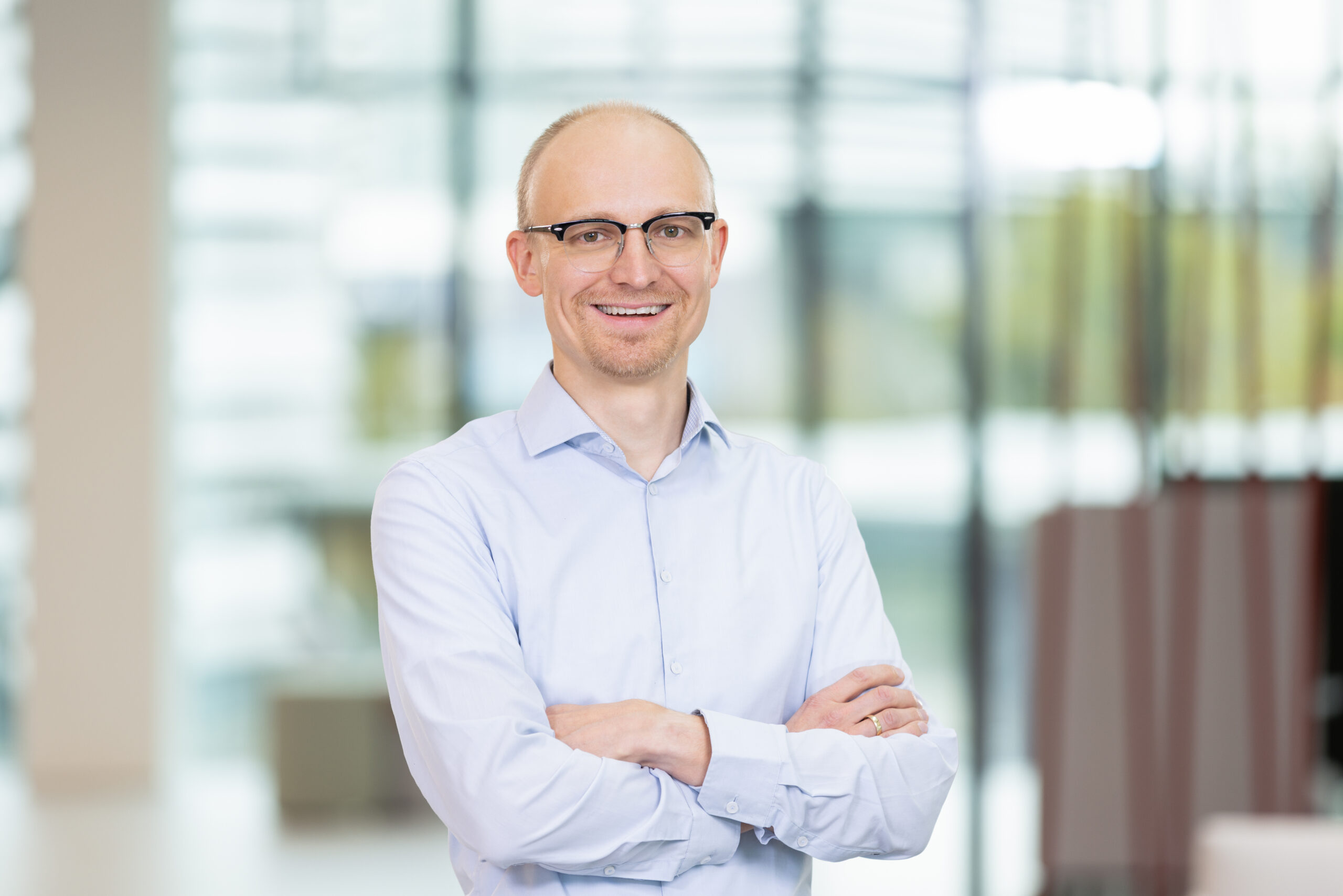
Professor Simon Steentjes, ehemaliger Studierender der RWTH Aachen University und neuer Inhaber des Lehrstuhl für Elektrische Maschinen und Antriebe ©Christian Schneider
Professor Simon Steentjes kehrte im Oktober 2024 an seinen akademischen Herkunftsort zurück und übernahm den Lehrstuhl für Elektrische Maschinen und Antriebe.
Bereits in seiner Kindheit entwickelte der 37-jährige Professor eine Leidenschaft für Technik, die ihn 2006 erstmalig an die RWTH Aachen University führte, wo er sein Studium der Elektrotechnik und Informationstechnik abschloss und anschließend bei seinem Vorgänger Professor Kay Hameyer promovierte.
„Ich habe von klein auf gelernt, Dinge zu reparieren, anstatt sie wegzuwerfen. Mein Vater hat mir als Kind alles gezeigt. Wir haben oft so lange getüftelt, bis die Sachen wieder funktionierten“, erinnert sich Professor Steentjes.
Dieser Erfahrungsschatz habe nicht nur seinen Sinn für Nachhaltigkeit geprägt, sondern auch in seiner Überzeugung resultiert, dass jedes Problem auf irgendeine Weise lösbar sei.
„Ich möchte für mein Kind und die nachfolgenden Generationen eine lebenswerte Welt hinterlassen und halte eine nachhaltige Entwicklung elektrischer Maschinen und Antriebe für absolut essenziell.“, versichert der Elektroingenieur.
Elektrische Maschinen sind für eine Vielzahl von Anwendungen essenziell, wie beispielsweise in Industrieanlagen, im Bereich der Mobilität, bei Haushaltsgeräten und in der Energieversorgung. Durch effizientere E-Maschinen und Antriebe bestehe daher ein großer Hebel zur Senkung der CO₂-Emissionen, was einen bedeutenden Beitrag zum Klimaschutz leisten könne, erläutert Professor Steentjes. Die kontinuierliche Weiterentwicklung dieser Technologie erfordere Forschung und Innovation, um Leistungs- und Drehmomentdichte sowie Wirkungsgrad zu steigern und Fertigungstechniken zu verbessern. Gleichzeitig spiele Ressourceneffizienz unter Einsatz neuer Technologien eine entscheidende Rolle. Um die Nachhaltigkeit und Effizienz unserer E-Maschinen zu optimieren, muss laut Professor Steentjes auch ein besseres Verständnis der zur Herstellung verwendeten Materialien und Ressourcen erlangt werden. Allein der Einsatz und die Fertigung von magnetischen Materialien, die in jeder elektrischen Maschine stecken, berge ein großes Optimierungspotenzial, welches aber zuerst verstanden werden müsse.
„Der Entwicklungsfortschritt beteiligter Disziplinen und Komponenten wird bisher kaum berücksichtigt. Die Fertigungstechnik entwickelt sich rasant, aber wir müssen diese Entwicklungen auch in der Herstellung und Konzeption von E-Maschinen mitdenken, um das volle Potenzial zur Effizienz- und Leistungsdichtesteigerung unserer Designs auszuschöpfen“, stellt der Aachener Ingenieure fest.
Simon Steentjes ist Forscher mit Leib und Seele. Es macht ihm Spaß, mit Wissenschaftlerinnen und Wissenschaftlern zu diskutieren, zu forschen und letztlich eine Lösung für bestehende Fragen und Probleme zu finden. Auch die Zusammenarbeit mit Studierenden und Doktoranden empfindet er als sehr bereichernd. Die Arbeit mit jungen Menschen bringe stets neue Ideen und helfe ihm dabei, am Puls der Zeit zu bleiben. Es sei schön, nun wieder in der Lehre aktiv zu sein, sagt Professor Steentjes.
Der Elektroingenieur kehrte mit einem Erfahrungsschatz aus der Industrie zurück in das akademische Umfeld. Bei der Audi AG erfolgte der Einstieg direkt im Bereich der Elektromobilität. Bei der Hilti Group, wo er 2022 die Leitung für die Elektromotoren und Antriebstechnologie übernahm, führte er unter anderem eine neuartige E-Motoren-Plattform für Elektrowerkzeuge von der Entwicklung bis zur Serienproduktion ein. Während seiner Tätigkeit in der Industrie habe er die Relevanz des Feedbacks aus der Praxis für das Design und die Entwicklung elektrischer Maschinen erkannt. Dies umfasse die Berücksichtigung der Bedürfnisse und Herausforderungen der Serienfertigung bereits in der Entwicklungsphase.
Während seiner Industrietätigkeit betreute er rund 20 Abschlussarbeiten. Trotz seiner Jahre in der Industrie blieb er der Wissenschaft verbunden und veröffentlichte kontinuierlich. Für ihn war immer klar, dass er irgendwann zurück in die Forschung gehen wollte. Professor Steentjes hatte das Glück, sein Hobby zum Beruf machen zu können. Er finde es wichtig, das zu tun, was einen glücklich macht, sagt er. Und genau diese Einstellung gibt er auch an seine Studierenden weiter:
„Als Professor hat man die Verantwortung, die nächste Generation mit Wissen auszustatten, sie zu motivieren und zu ermutigen, dem eigenen Können zu vertrauen.“
Den Weg zurück in die Wissenschaft hat er nun gefunden. Die Rückkehr an die RWTH sei für ihn eine ganz persönliche Mission gewesen, auf die er, unterstützt durch seine Familie, hingearbeitet habe. Die familiäre Unterstützung ist dem Ehemann und Vater besonders wichtig. Und wenn er nicht gerade an neuen elektrischen Maschinen oder Antrieben forscht, dann tüftelt er am liebsten an der Motorisierung von Legofahrzeugen mit seinem Sohn.
Geburtstagsausgabe der RWTH-Wissenschaftsnacht „5 vor 12“
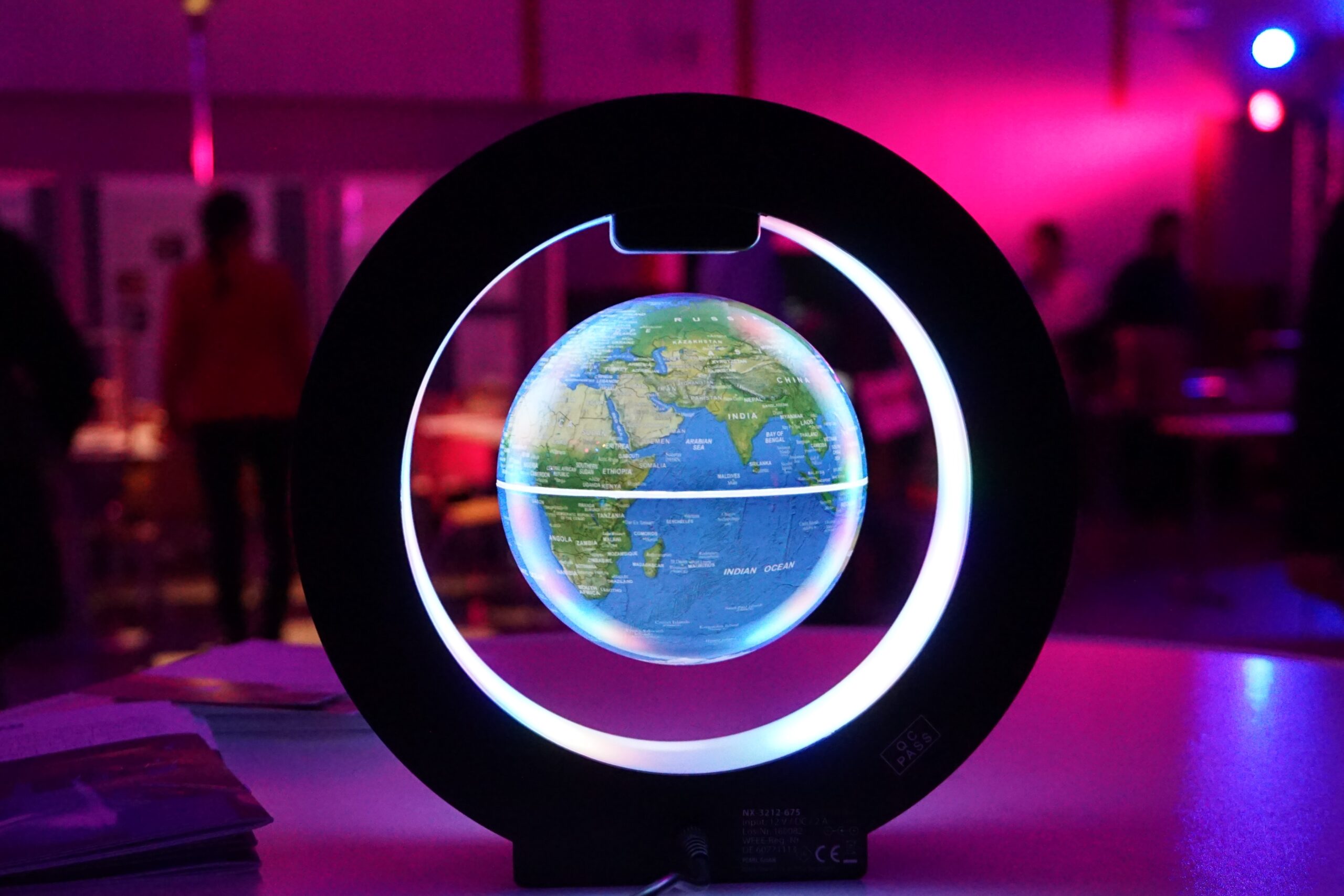
Der magnetische Globus dreht sich schwerelos um die eigene Achse – wie in der Wirklichkeit des Weltraums
20 Mal ließ die RWTH Aachen University sich hinter ihre Kulissen blicken. Dieses Mal fanden sich 7200 Besucherinnen und Besucher, darunter zahlreiche Kinder, wischen 18 Uhr und Mitternacht im Hörsaalzentrum C.A.R.L. ein und erlebten die Welt der Forschung aus eindrucksvoller Nähe.
Die anfänglich bescheidene Idee, Wissenschaft zu ungewöhnlicher Zeit, unterhaltsam und kostenfrei für alle Interessierten zu präsentieren, hat sich im Verlauf der vergangenen 20 Jahre zu einem Megaevent entwickelt, das nicht nur Tausende von Gästen anzieht, sondern auch die beteiligten Hochschulangehörigen gleichermaßen begeistert. Auch die Mitarbeitenden des Fachbereichs Elektrotechnik und Informationstechnik empfingen wieder wissbegierige und experimentierfreudige Kinder jeden Alters und standen ihnen beim buchstäblichen Begreifen unterstützend zur Seite.
Mit Fragen wie „Warum geht die Lampe jetzt nicht mehr an?“, „Wie funktioniert das?“ oder „Kann ich noch ein Experiment machen?“ folgten die jüngeren Kinder ihrem natürlichen Drang, Neues zu entdecken.
Dabei bauten sie verschiedene Stromkreise nach, in denen sie elektrischen Strom als Licht oder Bewegung sichtbar machen konnten. Sie bastelten Schalter, untersuchten die magnetische und thermische Wirkung von Strom, lernten Leiter von Nichtleitern zu unterscheiden und entwickelten schließlich ein Gefühl für Elektrizität.
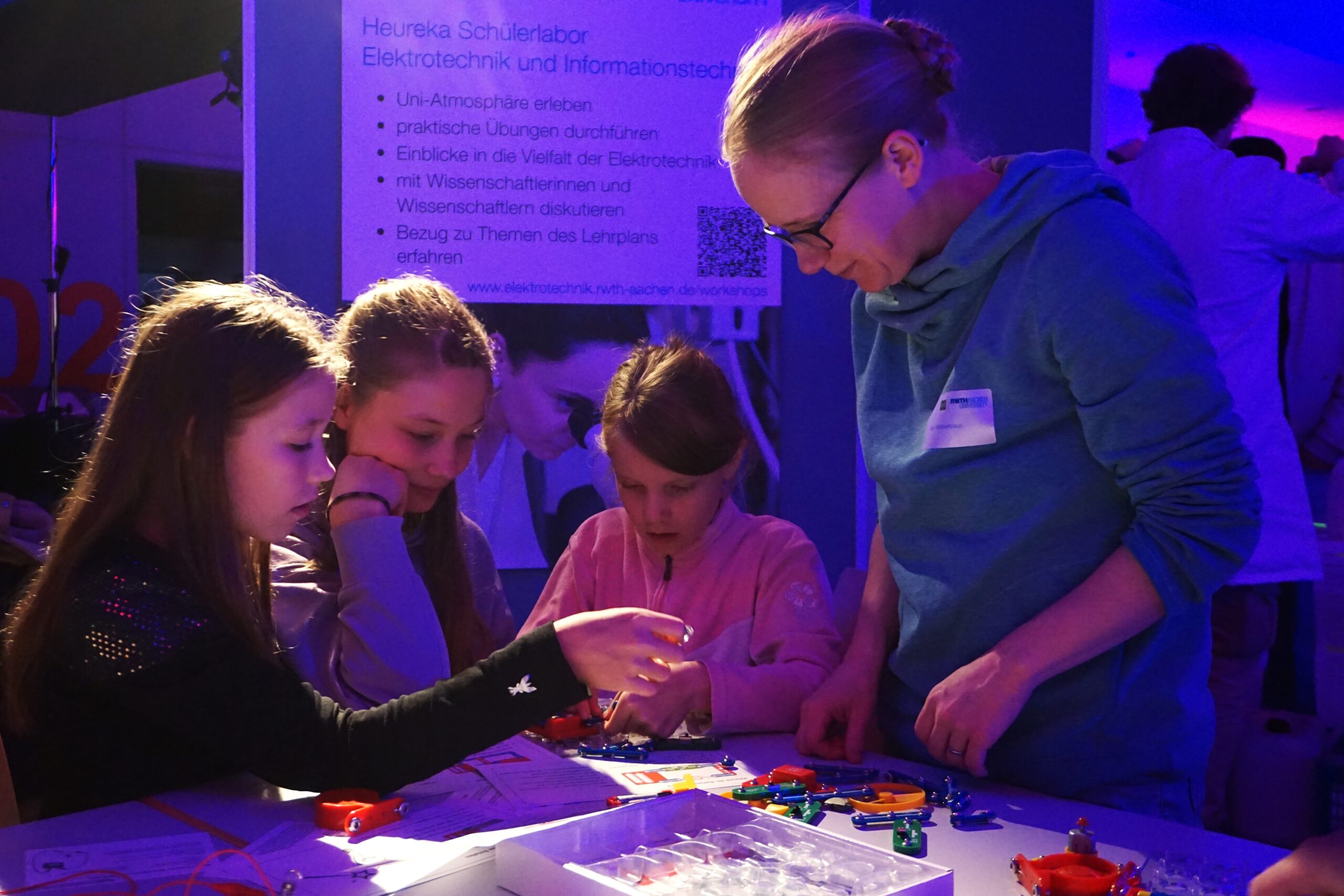
Fakultätsangehörige unterstützen beim Experimentieren mit Stromkreisen
Ältere Kinder „hatten das schon in der Schule“ und stellten ihr theoretisches Wissen gerne auf den Prüfstand. Aber auch Erwachsene fanden sich an unserer Station ein, nutzten die Gelegenheit, mit der Influenzmaschine Blitze zu erzeugen, verweilten gedankenversunken vor dem schwebenden Globus oder studierten aufmerksam das Modell des Stromverteilnetzes, welches der Lehrstuhl für Automation of Complex Power Systems aufgestellt hatte. Die Freude am gemeinsamen Erleben von Forschung und Fortschritt steht bei der Wissenschaftsnacht ganz klar im Mittelpunkt.
„Wir wollen auf unterhaltsame Weise zeigen, was die RWTH alles drauf hat – und zwar so, dass Alle, die etwas wissen wollen, es auch verstehen“, sagte Rektor Ulrich Rüdiger.
Das Potenzial der Wissenschaftsnacht ist folglich noch höher zu veranschlagen: Sie stellt eine wichtige Schnittstelle dar, an der der unmittelbare Wissenstransfer in einem sozialen und kulturellen Kontext erfolgt. Gemäß dem Motto „aus den Laboren zu den Menschen“ leistet dieses jährliche Event einen wichtigen Beitrag zur Förderung der Nähe zwischen Wissenschaft und Gesellschaft.
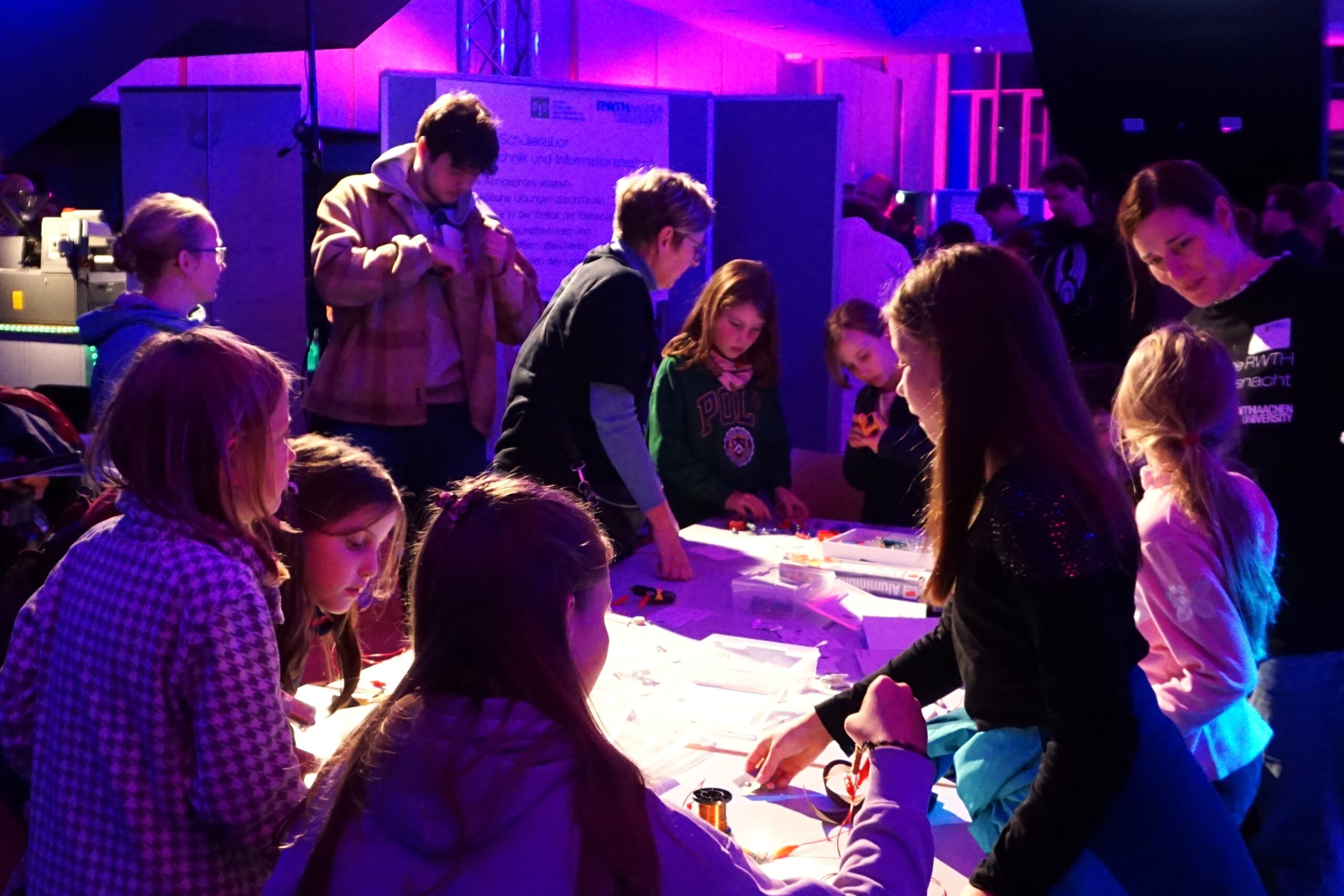
Die Station der Fakultät für Elektrotechnik und Informationstechnik, ausgestattet mit zahlreichen kindergerechten Experimenten
Das Programm der diesjährigen Wissenschaftsnacht erstreckte sich über zehn Hörsäle und zahlreiche Seminarräume. Es gab über 80 Shows und Vorträge, Experimente, Talks und Diskussionen. Von Künstlicher Intelligenz (die Expertinnen und Experten des KI-Centers der RWTH hatten zur Verstärkung noch den Roboter „Pepper“ mitgebracht) bis zum „Jahrmarkt der Physik“, von aktuellen Infos zur US-Wahl und der spektakulären „Faszination Hochspannung“ über Kreislaufwirtschaft bis zu schwimmenden Teslas und der Baustelle der Zukunft. Die Themenpalette war so bunt und vielfältig wie die RWTH selbst.
Weitere Informationen zu dem Programm, sowie Eindrücke und Erfahrungen der Organisatoren – Dezernat für Presse und Kommunikation, Abteilung 3.2 – sind über die Verlinkungen abrufbar.
Who run the work? – Team ÜEW
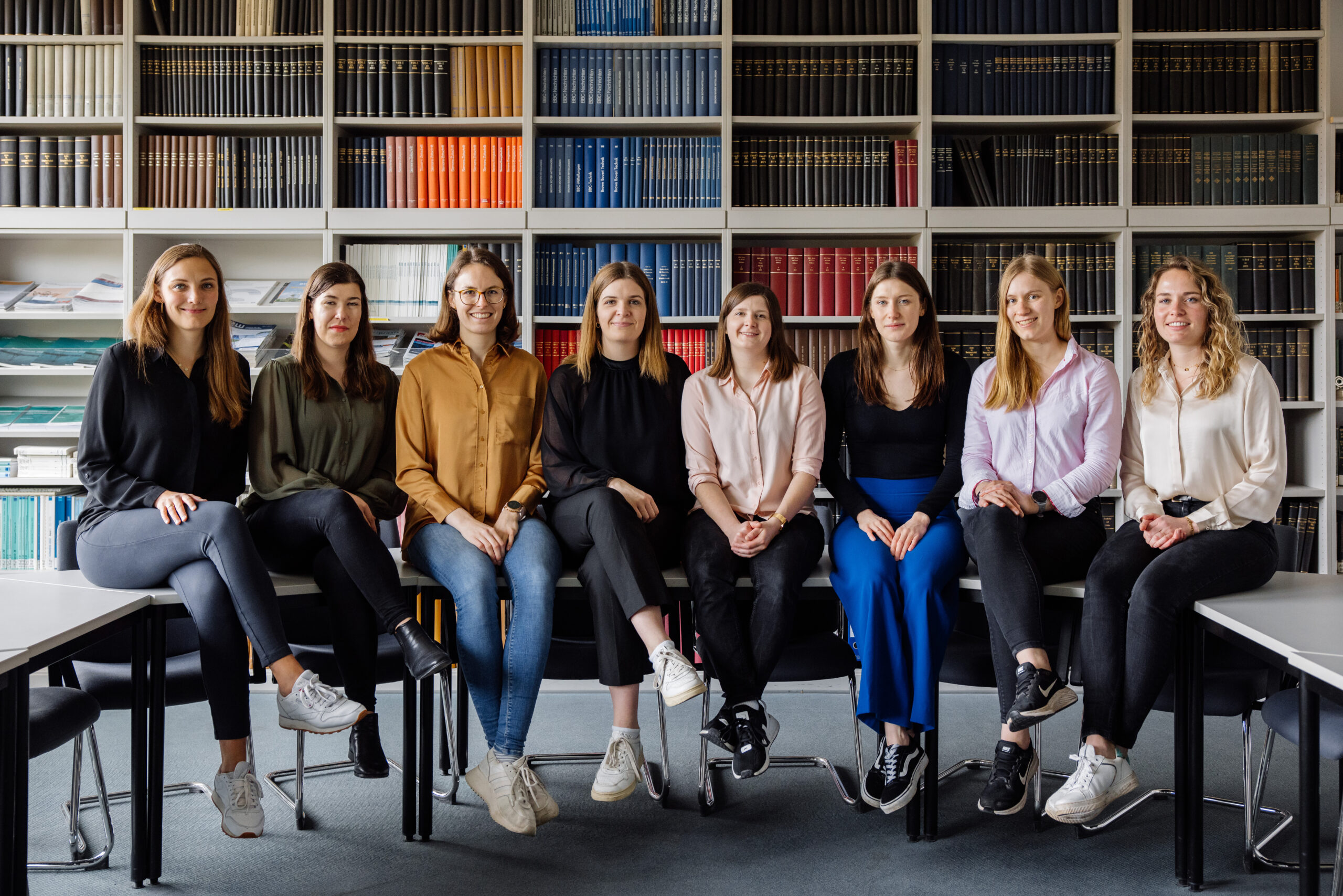
Von links: Stefanie Samaan, Ricarda Kriete, Carolin Guntermann, Sophia Tepe, Lina Fischer, Muriel Krüger, Jana Einsiedle, Claire Lambriex © Martin Braun
Ein Blick in das Team des Lehrstuhls für Übertragungsnetze und Energiewirtschaft (ÜEW) am Institut für Elektrische Anlagen und Netze, Digitalisierung und Energiewirtschaft (IAEW) zeigt ein für die Elektrotechnik erfreuliches Bild: Es besteht zu fast einem Drittel aus weiblichen Mitarbeiterinnen.
Der Frauenanteil in den Ingenieurwissenschaften ist in den letzten Jahren gestiegen und Ingenieurinnen sind insbesondere im Forschungsbereich selbstverständlicher Bestandteil eines Institutsteams. Als wissenschaftliche Mitarbeiterinnen haben alle im Team ein ingenieurwissenschaftliches Studium im Bereich der Elektrotechnik absolviert und sich danach entschieden, eine Doktorarbeit an der Universität anzuschließen und ihre berufliche Karriere hier zu starten. Natürlich setzt die Arbeit in der Elektrotechnik ein gewisses Interesse an Naturwissenschaft und Technik voraus, doch der Schlüssel zum Erfolg und Spaß an den Themengebieten liegt meistens vor allem in der Neugierde, neue Sachverhalte verstehen zu wollen.
„Die Frage: ‚Wie funktioniert das?‘ treibt uns immer wieder an“, sagt Lina Fischer, die an einem robusten Planungsmodell für das zukünftige Energiesystem forscht.
Als nächstes braucht es einfach eine Portion Mut, um solchen Fragen tatkräftig nachzugehen – auch wenn das bedeutet, sich auf etwas Unbekanntes einzulassen.
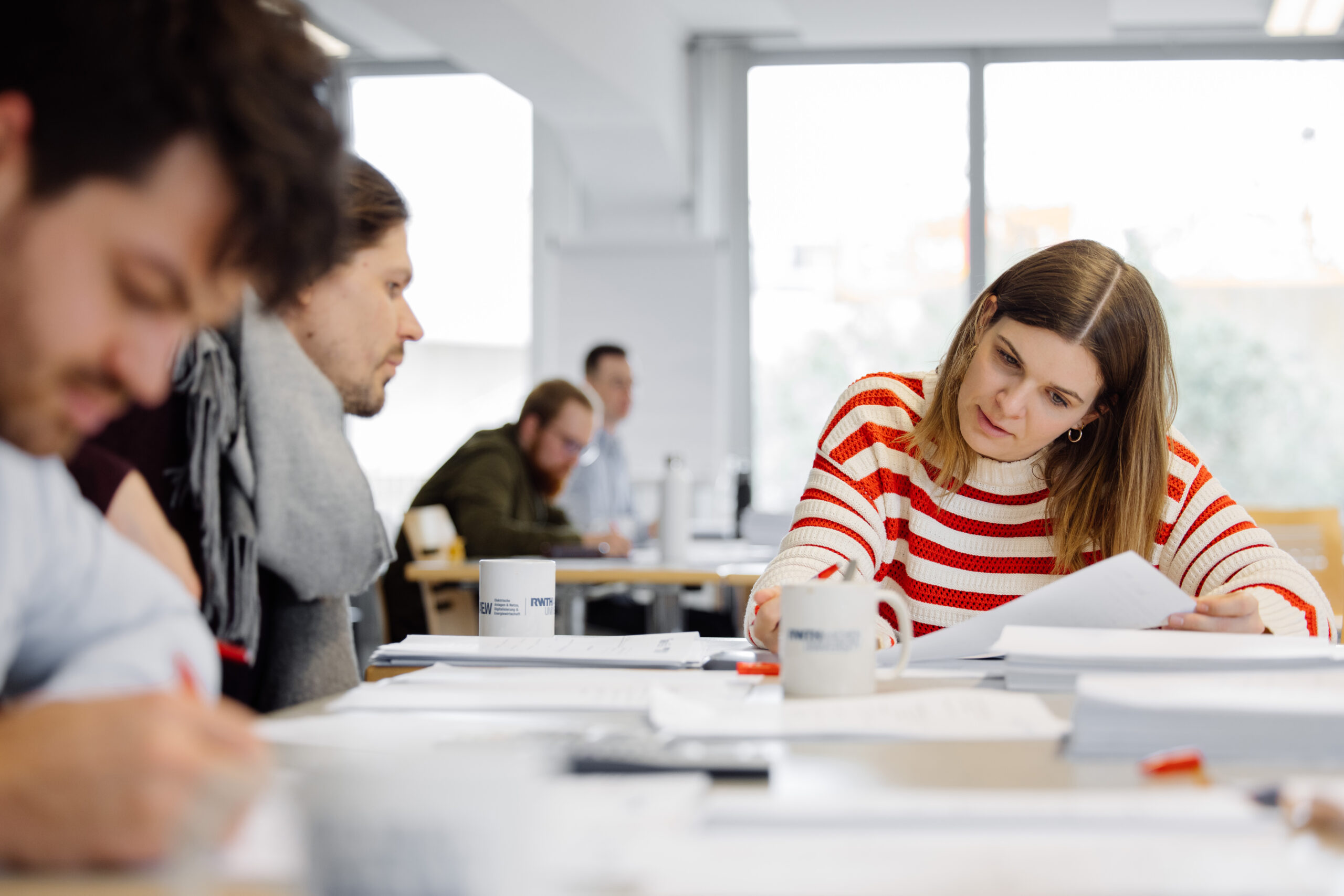
© Martin Braun
Alle am IAEW verbindet die Vision, Lösungen für die Energiewende zu erforschen und zu erarbeiten. Die Arbeit am Lehrstuhl für Übertragungsnetze und Energiewirtschaft beschäftigt sich vor allem mit der Frage:
„Wie sollen wir das zukünftige Energiesystem gestalten, sodass es umweltverträglich, versorgungssicher und gesamtwirtschaftlich effizient ist?“
Thematisch umfasst dies ein großes Spektrum an interessanten Aspekten. So dreht sich viel darum, wie die großen Energiemengen aus Photovoltaik- und Windenergieanlagen aber auch alternative Energieträger wie Wasserstoff in unser derzeitiges Energiesystem integriert werden können. Essentiell hierfür ist das Übertragungsnetz für Strom, welches man im Alltag z.B. an den neben den Autobahnen verlaufenden Hochspannungsleitungen erkennt. Dieses ermöglicht es, Strom über große Distanzen zu transportieren und somit die großen Energiemengen aus Windkraftanlagen in Norddeutschland zu Regionen mit hohem Stromverbrauch zu transportieren. Im Rahmen von aktuellen Projekten wird dabei untersucht, wie das Übertragungsnetz zukünftig ausgebaut und betrieben werden muss, um die Energiewende zu ermöglichen. Auch wird erforscht, an welchen Standorten zukünftig Leitungen zu den Offshore-Windkraftanlagen in der Nord- und Ostsee angeschlossen oder große Elektrolyseanlagen zur Produktion von Wasserstoff positioniert werden sollten. Solche Untersuchungen müssen neben technischen Aspekten der Komponenten auch wirtschaftliche Aspekte miteinbeziehen, wie z.B. die entstehenden Kosten durch Investitionen oder mögliche Engpässe im Übertragungsnetz.
Generell spielt die Betrachtung von wirtschaftlichen und marktlichen Aspekten bei der Umgestaltung des Energiesystems eine große Rolle. Durch die europäischen Bestrebungen, den Stromhandel zwischen den einzelnen Ländern weiter zu stärken, kommt es zu zunehmenden Handelsflüssen in Europa und dadurch zu weiteren Herausforderungen für die Transportaufgaben im Übertragungsnetz. Daher werden am Lehrstuhl Methoden und Modelle für die Simulation der europäischen Strommärkte entwickelt. So können verschiedene Zukunftsentwicklungen untersucht und ihre potenziellen Auswirkungen für die Marktteilnehmer sowie das Übertragungsnetz analysiert werden.
Ein weiterer Themenschwerpunkt des Lehrstuhls ist es, sich mit innovativen Betriebsmitteln und Konzepten zu beschäftigen, welche zukünftig einen sicheren Betrieb der Übertragungsnetze gewährleisten und so vor Blackouts schützen sollen. Hierfür müssen vor allem Modelle und Verfahren entwickelt werden, die das dynamische Systemverhalten der Übertragungsnetze und ihrer Komponenten unter neuen Rahmenbedingungen abbilden und untersuchen können.
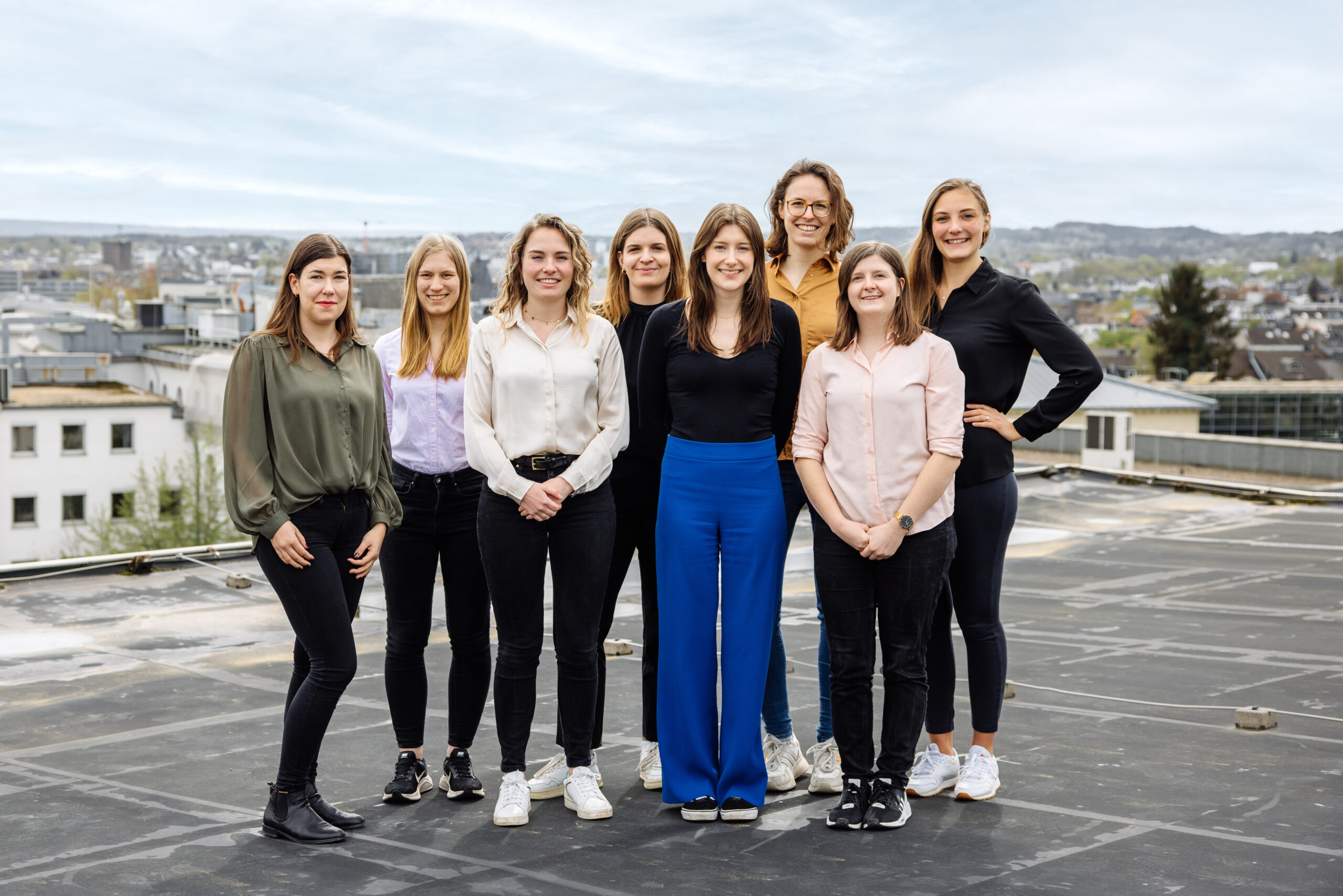
© Martin Braun
Wenn man an die Arbeit an einem Institut der Universität denkt, drehen sich die ersten Gedanken meistens um die alleinige Arbeit an einem eigenen Forschungsvorhaben. Dies vermittelt besonders im Bereich der Ingenieurwissenschaften oft einen falschen Eindruck des Arbeitsalltags an einem Institut. So ist die Arbeit am IAEW vor allem durch die Vielfalt an verschiedenen Projekten mit sowohl Forschungs- als auch Industriepartnern geprägt. Dies erlaubt es, unterschiedliche Themengebiete kennenzulernen und vielfältige Erfahrungen zu sammeln. Häufig ist man ab der Anbahnung der Projekte über die Bearbeitung bis hin zur Präsentation der Ergebnisse involviert. Die unterschiedlichen Projektteams machen die Zusammenarbeit dabei abwechslungsreich. Durch die Zeit am Institut bietet sich dadurch die Möglichkeit, neben wissenschaftlichen Erkenntnissen auch eine Reihe an Fähigkeiten zu erwerben, die für Führungsaufgaben in der Industrie qualifizieren.
Natürlich erlebt man auch abseits des Arbeitsalltags vielerlei Dinge, die die Arbeit am Institut lohnenswert machen.
„Besonders die gemeinsamen Aktivitäten mit anderen jungen Kolleginnen und Kollegen nach der Arbeit, diverse Institutstraditionen, Feste und sportliche Events gehören mit dazu.“
Das IAEW bietet dabei insbesondere auch die Möglichkeit, schon während des Studiums durch eine Hiwi-Stelle oder eine Abschlussarbeit Einblicke in den Institutsalltag und die Forschungsthemen zu bekommen.
Lass dich inspirieren und finde deinen eigenen Weg!
Auf unserer Website informieren wir dich über unser Studienangebot.
